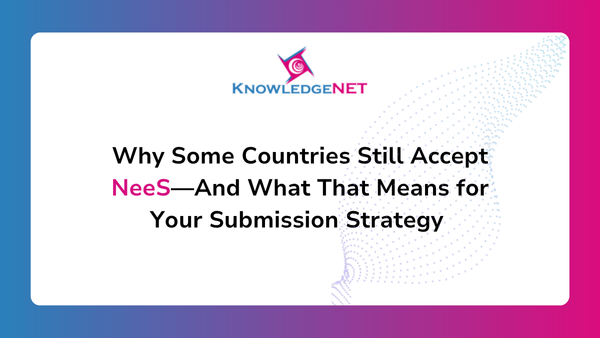Why Some Countries Still Accept NeeS—And What That Means for Your Submission Strategy
As the pharmaceutical industry increasingly adopts the electronic Common Technical Document (eCTD) as a global submission standard, Non-eCTD electronic Submissions (NeeS) continue to hold relevance in certain regions. Regulatory affairs professionals managing multi-region dossiers must understand where NeeS remains accepted, what limitations it presents, and how to plan an adaptable submission strategy accordingly.
This blog explores why NeeS still exists, which markets continue to support it, and how organizations can prepare for an eventual transition to full eCTD compliance—without disrupting their regulatory timelines.
What Is NeeS? A Brief Overview
NeeS (Non-eCTD electronic Submission) is an electronic format for submitting marketing authorization dossiers. It mimics the CTD structure but does not require XML backbones, metadata, or lifecycle management capabilities, which are core to eCTD.
It was introduced as a transitional format for authorities not yet ready to implement full eCTD infrastructure. While eCTD is now the global gold standard, NeeS is still officially accepted or required in select markets—especially in regions undergoing regulatory digital transformation.
Why Do Some Countries Still Accept NeeS?
- Limited Regulatory Infrastructure
Not all agencies have the technical infrastructure, budget, or training to support full eCTD adoption. - Simplified Review Models
For certain product categories or local manufacturers, NeeS provides a functional, simplified electronic submission option. - Phased Digitalization
Many regulatory bodies are taking a gradual approach—starting with NeeS before mandating eCTD. - Flexibility for Small Markets
For regions with low submission volumes or localized pharmaceutical production, NeeS may still be operationally efficient.
Regulatory Authorities That Still Accept or Require NeeS Submissions
Below is a list of key markets where NeeS is still accepted or expected, as of 2025:
| Country/Region | Regulatory Authority | Status of NeeS |
| India | CDSCO – Central Drugs Standard Control Organization | Accepted (alongside CTD) |
| Indonesia | BPOM – National Agency of Drug and Food Control | Accepted |
| Philippines | FDA – Food and Drug Administration | Accepted |
| Vietnam | DAV – Drug Administration of Vietnam | Accepted / Hybrid |
| Pakistan | DRAP – Drug Regulatory Authority of Pakistan | Accepted |
| Bangladesh | DGDA – Directorate General of Drug Administration | Accepted |
| Kenya | PPB – Pharmacy and Poisons Board | Accepted |
| Nigeria | NAFDAC – National Agency for Food and Drug Admin | Accepted |
| Sri Lanka | NMRA – National Medicines Regulatory Authority | Accepted |
| Ukraine | State Expert Center | Accepted / Transitioning |
Note: While NeeS is accepted in these regions, many have announced long-term plans to transition to eCTD, and pilot programs are already underway in countries like India and Vietnam.
Limitations of NeeS Submissions
While NeeS offers short-term practicality, it comes with several drawbacks:
- No lifecycle management – Cannot efficiently handle variations, updates, or history tracking.
- Lack of metadata – Makes automated review and linking difficult for regulators.
- Inconsistent validation – Submissions often depend on manual verification.
- Limited scalability – Inefficient for companies with large or frequent submissions.
For global pharma companies, maintaining multiple submission formats adds complexity, compliance risk, and resource burden.
How to Plan Your Submission Strategy Around NeeS
If your target markets still support NeeS, consider the following best practices to future-proof your submission operations:
✅ 1. Use eCTD-Ready Tools from the Start
Even when submitting in NeeS, prepare your content in an eCTD-compatible structure so you’re ready to convert when the market transitions.
✅ 2. Maintain Country-Specific Dossier Templates
Ensure your regulatory team uses validated templates and region-specific guidance, especially for Module 1 content.
✅ 3. Track Regulatory Roadmaps Closely
Stay updated on each authority’s digitalization plans to anticipate when eCTD will become mandatory.
✅ 4. Design a Hybrid Submission Workflow
Build submission workflows that accommodate both eCTD and NeeS formats to reduce rework and maintain compliance across all regions.
✅ 5. Centralize Your Regulatory Content Management
Even if submission formats differ, centralizing your source content helps maintain control, reduce duplication, and support faster lifecycle updates.
Conclusion: Be Ready for the Shift from NeeS to eCTD
While NeeS submissions remain a valid route in several countries, the global trend is moving decisively toward eCTD. Forward-thinking regulatory operations teams should begin preparing for this shift—not just for compliance, but for efficiency, accuracy, and scalability.
By planning now, companies can ensure a smooth transition across all markets without the disruptions caused by fragmented or outdated submission formats.
We provide all type of submission and also help the needy one’s to migrade data to eCTD.

